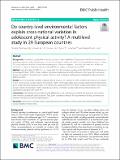Files in this item
Do country-level environmental factors explain cross-national variation in adolescent physical activity? A multilevel study in 29 European countries
Item metadata
| dc.contributor.author | Weinberg, Dominic | |
| dc.contributor.author | Stevens, Gonneke W. J. M. | |
| dc.contributor.author | Bucksch, Jens | |
| dc.contributor.author | Inchley, Jo | |
| dc.contributor.author | de Looze, Margaretha | |
| dc.date.accessioned | 2019-06-05T14:30:07Z | |
| dc.date.available | 2019-06-05T14:30:07Z | |
| dc.date.issued | 2019-06-03 | |
| dc.identifier | 259208766 | |
| dc.identifier | b1bee9ae-4f80-4422-8f0f-108d3cf119fe | |
| dc.identifier | 85066877020 | |
| dc.identifier | 000470117600001 | |
| dc.identifier.citation | Weinberg , D , Stevens , G W J M , Bucksch , J , Inchley , J & de Looze , M 2019 , ' Do country-level environmental factors explain cross-national variation in adolescent physical activity? A multilevel study in 29 European countries ' , BMC Public Health , vol. 19 , 680 . https://doi.org/10.1186/s12889-019-6908-9 | en |
| dc.identifier.issn | 1471-2458 | |
| dc.identifier.other | RIS: urn:9303ACF51422DF82D36F72A8EDF93C60 | |
| dc.identifier.other | RIS: Weinberg2019 | |
| dc.identifier.other | ORCID: /0000-0001-8322-8817/work/65014230 | |
| dc.identifier.uri | https://hdl.handle.net/10023/17822 | |
| dc.description.abstract | Background: Worldwide, roughly 80% of adolescents fail to meet World Health Organization (WHO) recommendations regarding physical activity, though there is substantial variation in adolescent physical activity prevalence across countries. This study explored whether country-level environmental differences explained cross-national variation in adolescent moderate- to vigorous-intensity physical activity (MVPA) and vigorous-intensity activity (VPA). Method: Using the data of 138,014 11- to 15-year-olds from 29 European countries in the 2013/2014 Health Behaviour in School-aged Children (HBSC) study, multilevel regression models examined the influence of four types of country-level environmental factors (physical, socio-cultural, economic, and political) on self-reported individual-level physical activity (MVPA and VPA). Results: The environmental variables explained 38% of country-level variance in MVPA and 81% of country-level variance in VPA. Lower annual average national temperature, higher community safety, lower average national household income and a weaker physical education policy were significantly associated with more MVPA. Greater urbanisation, lower annual average national temperature, higher adult physical activity and higher average national household income were significantly associated with more VPA. Conclusions: The findings showed that national differences in the physical, socio-cultural and economic environment were related to adolescent physical activity. They point to potential avenues for future research looking at interactions between individual and environmental factors. | |
| dc.format.extent | 11 | |
| dc.format.extent | 681424 | |
| dc.language.iso | eng | |
| dc.relation.ispartof | BMC Public Health | en |
| dc.subject | Adolescence | en |
| dc.subject | Physical activity | en |
| dc.subject | Ecological theory | en |
| dc.subject | Environmental determinants | en |
| dc.subject | International comparison | en |
| dc.subject | Europe | en |
| dc.subject | Multilevel model | en |
| dc.subject | HBSC | en |
| dc.subject | RJ101 Child Health. Child health services | en |
| dc.subject | 3rd-DAS | en |
| dc.subject | SDG 4 - Quality Education | en |
| dc.subject.lcc | RJ101 | en |
| dc.title | Do country-level environmental factors explain cross-national variation in adolescent physical activity? A multilevel study in 29 European countries | en |
| dc.type | Journal article | en |
| dc.contributor.institution | University of St Andrews. School of Medicine | en |
| dc.contributor.institution | University of St Andrews. Population and Behavioural Science Division | en |
| dc.contributor.institution | University of St Andrews. Child and Adolescent Health Research Unit | en |
| dc.identifier.doi | 10.1186/s12889-019-6908-9 | |
| dc.description.status | Peer reviewed | en |
This item appears in the following Collection(s)
Items in the St Andrews Research Repository are protected by copyright, with all rights reserved, unless otherwise indicated.

